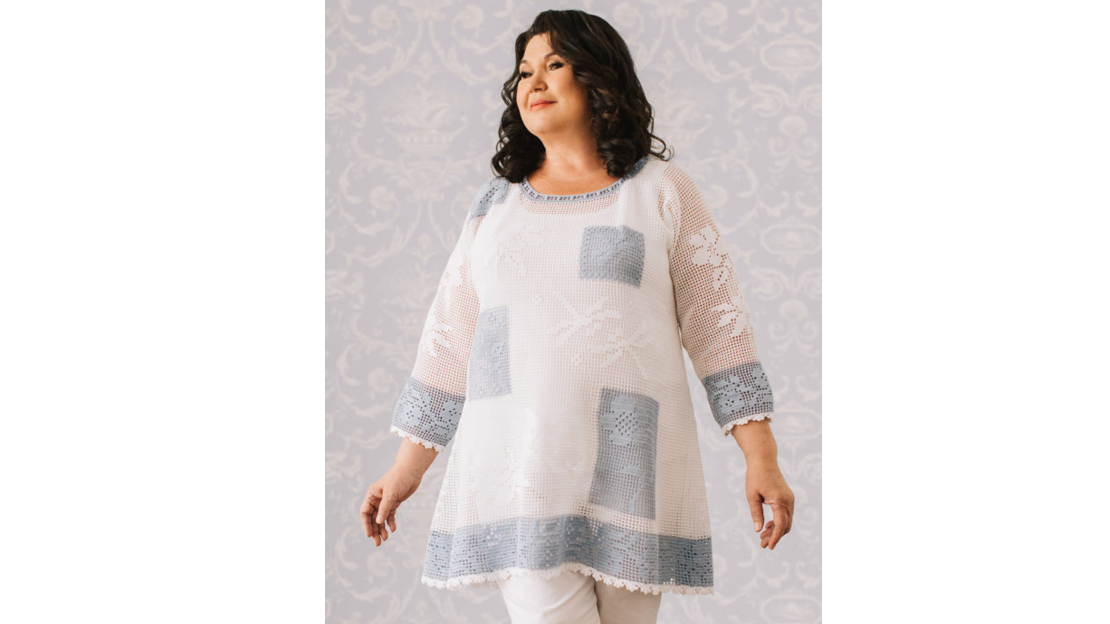
Туника «Белый туман»в технике пэчворк.
Recommended yarn: Anna 16 (100g/530m)
Clover hook No. 1
Yarn consumption: 600 g
Белой пряжи — 3.5 моточка, голубой около 2-х.
Size 60.
Длина туники — 80см.
This post contains a detailed description of knitting colored fragments into the main fabric of the tunic, knitting the hanging corners of the tunic (if such are suggested by the style of the product), as well as two links to MK on constructing a product pattern according to the fillet pattern, and a detailed explanation of the procedure for making the product using the fillet technique. Valentina Dyachenko.
Worth a look:
«Как построить выкройку по филейному рисунку.
МК от Валентины Дьяченко»
You can view and study in detail the tutorial on knitting products using the fillet technique, which is offered by Valentina Dyachenko here:
The detailed MK of Valentina Dyachenko somewhat helps to understand how to knit insert fragments into fillet fabric.
The calculation of the required number of cells (as well as the number of VPs to start knitting) is described in detail in the post, which can be accessed via the previous link.
We tie the beginning with a thread of the main color:

Основная нить остаётся всегда с правой стороны, в данном случае — белая. Привязываем цветную нить в нужном месте и начинаем вязать узор, который понравился, как вставной фрагмент. В предлагаемом примере фрагмент «Роза» имеет в высоту 26 рядов (должно быть чётное количество клеток в высоту, чтобы нитка вернулась на ту сторону изделия, с которой начали вязать). В данном примере вяжем розу по этой схеме:

They tied a red thread and began to knit a fragment with a rose:


After the snippet is finished:

We cut the thread and carefully hide it with a needle like this:

After steaming the fragment, this place cannot be found at all. It is recommended to hide the threads when you already know for sure that you won’t have to retie.

Now the most important thing in Patchwork: how to continue knitting with the main thread after completing the knitting of the fragment. Or in other words, embedding a fragment.
Scheme for tying the insert fragment with the main thread:

The diagram, in my opinion, does not provide an accurate understanding of how to correctly attach the main thread to a colored fragment.
But a large number of photographs taken by Valentina Dyachenko at each stage of this process complement the picture. Many thanks to the master!

There is now one loop on the hook. Next: 2 ch and insert the hook into the next dc of the colored fragment, knit in 1 single loop. That is, we go up along the edge of the fragment.

Now we turn the work so that it is convenient to knit in the opposite direction, with a fillet mesh in this case. And we repeat all the steps described above.

After we have finished tying the fragment with the main fabric, we continue to knit the entire row with the main thread according to the pattern.

Or we knit other fragments, checking the tunic diagram. Here is an example of the arrangement of colored fragments of another tunic:

What else do you need to know to knit this tunic? Of course, knitting the corners of the tunic if you want them to sag at the sides of the tunic.
Knitting the corner of the tunic
The corner can be knitted directly from the armhole or from the waist if desired.
There is only one principle: 1) tie a thread at the beginning of the hem of the back or front (it doesn’t matter); 2) we knit according to the pattern to our corner (to the armhole or to the waist) without knitting 3 squares; 3) we start without VP, immediately knit without finishing 1/2/3 cells on one side and 1/2/3 cells on the other side; 4) knit 3+3+1, the first loop on the hook into one loop.
Photos demonstrate the step-by-step implementation of this process:




This is how we knit our trapezoid in rotating rows. If you want a long angle. Then we knit 2 squares together.

Next, another method is proposed, the author of which is Tatyana Sopova.

So, we tie a thread in the middle behind the CH.
1 ряд — 3СН, 2ВП, привязываю во 2 клетку в СН, поворачиваю работу и в обратную сторону вяжу 2 ряд -2ВП , СН 1ВП СН 1ВП СН 2ВП привязываю во 2 клетку СН. Поворачиваем работу и вяже в обратную сторону. 3 ряд — 2ВП СН , 2ВП СН 2ВП СН 2ВП СН привязываем во 2 клетку В СН. , 4 ряд как 1. Показываю на фото поэтапно.





We repeat this until the end of our shelf and back, until all the cells are finished.
Now let's move on to the series of photographs that Valentina Dyachenko offers as MK on this tunic.

Рекомендуемая пряжа для туники «Белый туман» Анна 16


Below are a few photos showing how inserts of a different color are arranged:




Schemes of used and recommended patterns:












Trapezoid:

Sleeves:

Decreasing (narrowing the sleeves), one of the ways:










Hem and sleeves (banding)



Neck strap
1 Row RLS,
2 Row CH,
Row 3 CH 2 VP CH 2 VP etc. to the end of the row.
4 row CH 2 VP, CH, 1 VP (5 unfinished CH with one tip), 1 VP CH. so until the end of the row. 5 row sc.





Related posts
About the Author

Welcome !
My name is Lilia. The main hobby of my life is knitting. I started with knitting needles and switched to a knitting machine. In 1988 I got acquainted with crochet - Romanian lace. About 10 years ago I became interested in Irish lace and Shetland knitting. And now I’m trying fillet crochet. On this site I want to share with you my 45 years of experience in various knitting techniques.
Latest publications
Интересный пуловер с шишечками цвета охры
Перед долгой прогулкой нужно как следует утеплиться! Для этого нет ничего лучше пряжи из отборной овечьей шерсти и альпака, которая так хороша в теплых терракотовых тонах.
Свитер Cloudy Day
Оранжевый пуловер с узорами из «Кос»
Настоящее очарование ручной работы: яркий пуловер слегка небрежного покроя, украшенный фантазийными «косами», просто неотразим в сочетании с романтичным воздушным платьем!
Пуловер MODULAR
Blog Subscription
Be the first to receive new items!



